
The Critical Importance of Hydrogen-Based Monitoring Across Utility and Industrial Applications
In critical infrastructure environments—from power utility transformers to energy storage and industrial process facilities—hydrogen gas serves as both a valuable diagnostic indicator and an early warning sign of potential issues. Not knowing the presence of hydrogen can lead to catastrophic equipment failures, safety hazards and significant operational disruptions. Facility managers and maintenance teams responsible for critical assets and operations can better maintain operational integrity and safety by gaining a deeper understanding of hydrogen measurement principles and implementing reliable hydrogen monitoring solutions.
What is the Principle of Hydrogen Measurement?
The principle of hydrogen measurement involves specialized materials that interact with hydrogen molecules in ways that can be precisely measured. Advanced hydrogen-based transformer monitoring systems, like those developed by H2scan, utilize technology based on a unique relationship between hydrogen and rare precious metals.
When hydrogen molecules contact certain metal surfaces, they dissociate into atomic hydrogen, diffusing into the lattice in amounts proportional to the hydrogen concentration present. This interaction creates measurable changes in electrical properties that provide highly accurate readings specific to hydrogen.
This critical specificity eliminates false alarms from other gases that might be present in industrial environments. H2scan’s hydrogen-specific sensing systems can detect hydrogen without cross-sensitivities to other gases, separating them from all other inline measuring technologies.
How Does a Hydrogen Sensor Work?
H2scan’s hydrogen sensors work by employing sophisticated mechanisms built around the patented solid-state technology. At the core of their sensing approach is a dual-component system:
The sensors contain two primary elements: a metal insulator semiconductor (MIS) device that detects hydrogen atoms as a charge at material interfaces, and a thin-film resistor whose resistance increases as hydrogen atoms distort the palladium lattice structure.
The operation involves several key processes:
- Selective adsorption: Hydrogen molecules adhere to the sensor surface where they break into atomic hydrogen.
- Lattice diffusion: The hydrogen atoms penetrate the rare-metal-based sensing material at rates proportional to hydrogen concentration.
- Property alteration: The diffused hydrogen causes measurable changes in the sensing material’s electrical properties.
- Signal processing: Advanced electronics convert these property changes into precise digital readings that can trigger alarms or provide continuous monitoring data.
What gives H2scan sensors their edge is their unique protective coating that enables continuous operation in harsh, contaminated environments where conventional sensors might fail or require frequent maintenance. The sensors self-calibrate without requiring calibration gases or costly site visits. This ensures consistent reliability and accuracy while significantly sparing the labor and time spent on maintenance and helps avoid operational downtime.
What are Hydrogen Sensors Used For?
H2scan’s hydrogen sensors are used for monitoring systems in three primary application areas:
- Transformer Health MonitoringInsight into transformer health helps staff know the condition of their transformer fleet to reliably meet power demands and avoid the small, but highly disruptive possibility of transformer failures and possible explosions.Hydrogen and other gases are generated when significant issues like overheating, partial discharge, and arcing occur in transformers. Why focus on hydrogen? Hydrogen is a key gas that appears before other gases, making it the perfect early warning indicator. Or to quote one industry expert, “When bad things happen in transformers, hydrogen is generated.” This early detection capability allows maintenance teams to identify abnormal transformer states before they escalate to catastrophic failures.
- Energy StorageVented lead acid and vented Ni-Cad batteries commonly used in battery rooms dissipate hydrogen that can reach flammable levels. Hydrogen area monitors detect these buildups and trigger alarms or ventilation systems when levels get too high.The rapid growth of battery energy storage systems (BESS) for renewable energy integration and grid modernization increases the critical task of hydrogen safety monitoring. Even small amounts of hydrogen can create explosive conditions in enclosed spaces.
- Industrial Process ApplicationsHydrogen is a key component of many industrial processes ranging from energy generation to chemical manufacturing, semiconductor production, etc. Hydrogen must be detected, analyzed, and measured quickly and accurately in these applications to improve process efficiency or avoid safety issues.By providing continuous hydrogen measurements in process streams, H2scan’s single gas (hydrogen) sensors enable facilities to optimize operations, ensure product quality and maintain safety compliance.
What are the Detection Techniques for Hydrogen?
Here are some of the detection techniques for hydrogen, each with distinct operating principles:
- Solid-State Sensors: These utilize rare metal alloys that are highly selective to hydrogen and operate without oxygen across ranges from a few ppm to 100% concentration. H2scan’s technology falls into this category, offering a high degree of accuracy, long life, zero maintenance and various equipment options that serve each of the three market segments that could benefit from monitoring solutions.
- Fuel Cell Sensors: These separate gas from oil via membranes, with hydrogen fueling an electrochemical cell. While cost-effective with proven technology, they typically require sensor replacement every 1-5 years and may respond to multiple gases rather than just hydrogen.
- Gas Chromatography: This laboratory-grade technology separates gases through specialized columns, providing exceptional accuracy but requiring gas bottles, periodic column replacement and ongoing calibration.
- Photo-Acoustic Spectroscopy: Using infrared light sources with specific filters, this technology measures sound pulses generated when gas molecules absorb and release energy. While offering good accuracy without gas bottles, this technology requires separate sensors for hydrogen.
- Electrochemical Sensors: These generate electrical signals proportional to hydrogen concentration, offering high accuracy for small leak detection with long operational lifespans.
Why is Hydrogen Hard to Detect?
Despite its ubiquitous presence, hydrogen is hard to detect due to unique measurement challenges:
- Physical properties: Hydrogen is colorless, odorless and the smallest molecule in existence, making it impossible to detect with human senses and allowing it to escape through the tiniest openings in containment systems.
- Rapid dispersion: Its extremely low density causes it to rise and disperse quickly in the air, creating dynamic concentration patterns that conventional periodic sampling methods often miss entirely.
- Escape behavior: Hydrogen escapes from transformer systems faster than any other gas, rendering traditional annual oil sampling ineffective for early detection of developing transformer abnormalities.
- Interference challenges: Hydrogen’s molecular properties make it difficult to detect in environments where other gases are present selectively. This is compounded by hydrogen’s tendency to interact with various materials, potentially masking its presence or creating false readings in less sophisticated detection methods.
These challenges have driven H2scan’s innovations in sensor technology, including proprietary protective barriers enabling continuous operation even in contaminated environments.

H2scan’s Advanced Hydrogen-Based Transformer Monitoring Solutions
H2scan offers several targeted product lines to address specific application needs:
For Transformer Monitoring:
The GRIDSCAN® 5000 Series pairs a high-performance ASIC with H2scan’s field-proven hydrogen sensor. These systems provide precision hydrogen measurement at a lower cost for high-volume OEM or utility applications. With no calibrations or maintenance needed, they represent the most cost-effective hydrogen-based transformer monitoring solution for transformer fleet monitoring, typically at 1/10 the cost of multi-gas DGA solutions.
The GRIDSCAN 6000 represents the industry’s only key-gas monitoring solution that measures hydrogen, moisture, pressure and temperature all in one unit. This integration of key transformer health indicators allows grid operators to obtain continuous, online data to assess the status of their transformer fleets. A ten-year warranty eliminates maintenance concerns and reduces operational costs.
The HY-VAULT™ transformer monitoring solution is designed to enhance the safety and reliability of network transformers. By integrating the GRIDSCAN 5000 series with the AVO-1, the HY-VAULT provides real-time insight into the condition of network transformer fleets.
For Battery Room Safety:
The HY-ALERTA® 5021 hydrogen area monitor is designed for battery room safety applications. It meets all code requirements, including continuous monitoring to keep hydrogen below 25% LFL (low flammability limit), communications to activate exhaust fans and Modbus communication for annunciation requirements. The sensor eliminates false positives by detecting only hydrogen and features a long lifecycle with self-calibration capability, without the need for calibration gases or costly site visits.
For Industrial Processes:
The HY-OPTIMA® Series provides continuous, hydrogen-specific process analyzers designed for ease of use, interface flexibility and accurate process control in industrial applications. Available in various configurations, these sensors operate in background gas streams in demanding industrial environments.
Take Control of Hydrogen Safety and Equipment Reliability
Undetected hydrogen can lead to catastrophic equipment failures, safety incidents and production disruptions. H2scan’s hydrogen-based transformer monitoring solutions provide reliable, maintenance-free operation, giving the user peace of mind and continuous insight into the condition of critical assets.
With over 15,000 sensor systems installed worldwide and over 1.3 billion field-proven service hours, H2scan offers unmatched reliability for hydrogen-based transformer monitoring across transformer monitoring, battery room safety and industrial process applications.
Appendix


